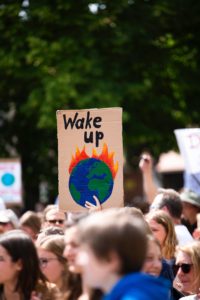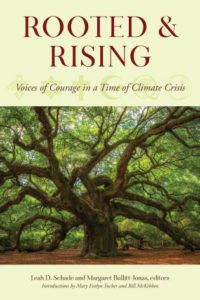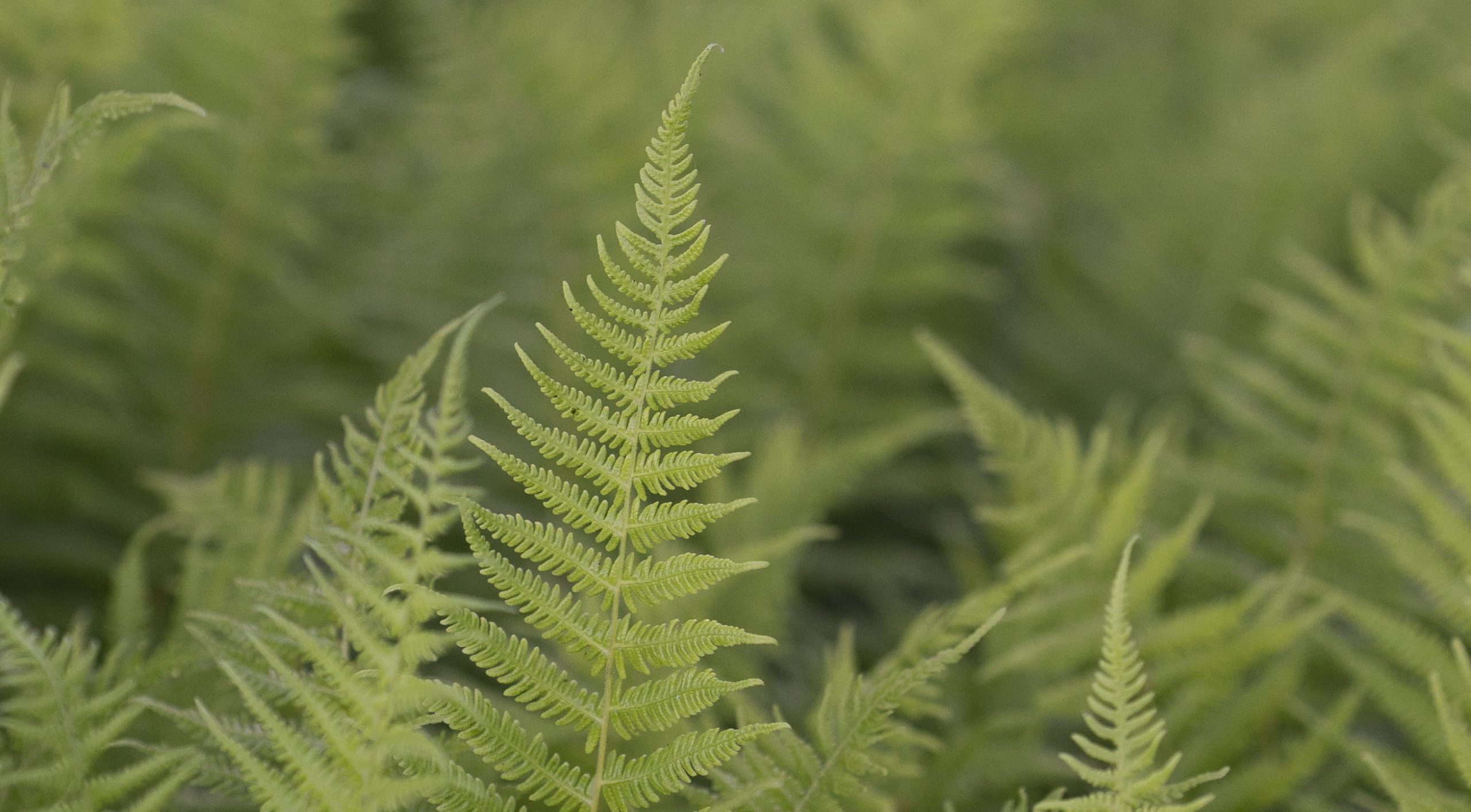Here we are this afternoon, gathered from our different neighborhoods, towns, and faith communities, like embers coming together to build up a fire. If you scatter the embers of a fire, they fizzle out. But if you bring them together, maybe blow on them a little, maybe add more fuel, before long you’ve got a roaring blaze. So let’s talk about fire.
Fire is on our minds these days. Many of us have watched videos of Greta Thunberg, the Swedish teenager with the round face and the straight blonde hair and those fierce, unyielding eyes, speaking with such intensity to the US Congress, to the UN COP meeting, to the World Economic Forum, telling the world – telling the adults who have failed to take action – “The house is on fire.” Our planetary home is on fire. It’s going up in flames.

Three kinds of fire
Last week I listened to Naomi Klein speak about her new book, On Fire: The (Burning) Case for a Green New Deal (NY: Simon and Schuster: 2019), and what I want to say is inspired by her remarks. Naomi Klein pointed out that actually we are dealing with two fires: one is the fire of a scorching planet as the climate crisis deepens. We know what that looks like: extracting and burning fossil fuels is warming the global atmosphere and setting new records for heat, month after month. Climate disruption is sparking wildfires in the Arctic and around the world; it’s causing massive droughts and record floods, monster hurricanes and rising seas. Parts of the planet will soon be too hot to inhabit, and the space in which human beings can survive is contracting. Last year the U.N. Intergovernmental Panel on Climate Change reported that in order to avert a catastrophic level of climate change, anything beyond a 1.5 degree Celsius rise in global temperature, we have only a short span of time – at this point, maybe eleven years – in which to initiate a transformation of our society and economy at a scale and speed that is historically unprecedented.
That’s Fire Number 1, the fire studied by climate science. Fire Number 2 is the fire of hatred. When people feel threatened, they can turn to a “strong man,” an authoritarian figure who promises to keep them safe by denying the humanity of other groups of people, by “othering” people who are weak or vulnerable or historically marginalized, the people who are not like us. This second fire is also raging, jumping from country to country: it’s alight in Brazil, in Turkey, and here in the U.S. Hatred says that some people are more worthy than others, that some people – the other people – should be left to drown or starve or die of heat – that’s not our problem, since we are the winners and they are the losers. Hatred is the voice of white supremacy and of every form of domination, greed, and exploitation.
So two fires are ablaze around the world, and feeding each other, but Naomi Klein pointed out that there is a third fire, too: our fire, the fire of our movement coming together at last – the youth climate strikes, the indigenous rights movement, the fossil fuel divestment movement, the climate justice movement, the frontline movement – and, I would add, the faith and environment movement – all of us coming together to douse the first two fires, and forge a path to a better future.
Naomi Klein didn’t say this, but I would call the third fire, the fire of love. This is where communities of faith have a vital role to play, for our task as faith communities, our vocation – indeed, our very reason for existence – is to tend and build the fire of love. How do we access that fire? How do throw off our helplessness, inertia, and despair, reach into our deep reserves of wisdom and courage, and rise up to take part into the movement to heal the web of life? I’m very interested in that question – so interested, in fact, that a friend and I asked colleagues in the faith and environment movement to write about their sources of spiritual strength. What gives them courage? What gives them hope? Our anthology of essays will be published on November 15 and it’s called Rooted and Rising: Voices of Courage in a Time of Climate Crisis.

Three ways to build love’s fire
I’d like to name three ways that individuals and communities of faith can build the fire of love in this precarious time.
First, we can teach practices that nourish the heart. For instance, go outdoors and fall in love again – or for the first time – with the natural world. Let the wind or the tree, the hoot of an owl or the shining face of the moon – let them speak to you of the love of God. The natural world saves us just as much as we save the natural world – the healing is mutual, for we belong to each other; we are kin.
Rediscovering the sacredness of the web of life can nourish the heart.
So can the practice of gratitude, the discovery that everything is gift – this moment, this breath – ah! It’s all gift! What a blessing to be alive just now, and at a time when our choices make such a difference!
Or again, we nourish the heart when we move through each day mindfully, paying attention, remembering that every person we meet is precious in God’s sight and worthy of care and respect.
That’s the first great gift that communities of faith can give the world in such a frightening time: practices of prayer and community, practices of meditation and story-telling, practices of singing and ceremony, that connect us with a sacred, loving Power beyond ourselves. Sharing practices that nourish the heart – that’s the first thing we can do to tend the fire of love.
Second, we can create spaces and ceremonies that allow our hearts to break. All of us need to grieve. We have lost so much, and we face more loss ahead. How do we pray about ecocide, about the death that humanity is unleashing upon Mother Earth and upon ourselves? The climate crisis can overwhelm us and make us go numb. But it is important to protect our human capacity to feel our emotional responses to the crisis, for that is how we stay inwardly vital and alive. What’s more, our emotions can become a source of energy for action to address the emergency.
So I’ll tell a story about grief that I included in my chapter for Rooted and Rising.
Recently a company began cutting down trees in the woods behind my home, clearing space for co-housing, an intentional neighborhood of private homes that share a common area and develop a strong sense of community. I’m all for co-housing and I’ve met some nice people who plan to live there, but, honestly, I grieve the trees. They have been companions to me, and sources of beauty. They are living presences that I know play a vital role in keeping life on Earth intact. Scientists tell us that we can’t stabilize the climate unless we save trees. Preserving forests is critical to combating climate change.1
Because of all this, I’ve taken to praying outdoors. I go outside, feel the good earth beneath my feet and the wind on my face, and I sing to the trees, to oak and beech, hemlock and pines. Making up the words and music as I go along, I sing my grief to the trees that are going down, and my grief for so much more – for what we have lost and are losing, and for what we are likely to lose. I sing my outrage about these beautiful old trees being cut to the roots, their bodies chipped to bits and hauled away to sell. I sing my fury about the predicament we’re in as a species. I sing my protest of the political and corporate powers-that-be that drive forward relentlessly with business as usual, razing forests, drilling for more oil and fracked gas, digging for more coal, expanding pipeline construction, and opening up public lands and waters to endless exploitation, as if Earth were their private business and they were conducting a liquidation sale. I sing out my shame to the trees, my repentance and apology for the part I have played in Earth’s destruction and for the part my ancestors played when they stole land from the Native peoples who lived here and chopped down the original forests. I sing my praise for the beauty of trees, and my resolve not to let a day go by that I don’t celebrate the precious living world of which we are so blessedly a part. I’m not finished until I sing my determination to renew action for trees and all of God’s Creation.
I feel God’s presence when I pray like that. I dare to believe that the Spirit who longs to renew the face of the Earth is praying through me. Praying like this leaves me feeling more alive, more connected with myself and with the world I love.
Here’s a third way that faith communities can tend the fire of love: we take up actions to heal the planet as a form of spiritual practice. When it comes to climate change, there is so much we can do! Maybe we can plant trees. Save trees. Recycle more. Drive less. Drive electric. Eat local, eat organic, eat less meat and move to a plant-based diet. Maybe we can support local farms and land trusts. We can fly less – and, if we must fly, buy carbon offsets. Maybe we can afford solar panels and move toward a carbon-neutral home. If we have financial investments, we can divest from fossil fuels. If we’re college graduates, we can push our alma mater to divest, as well.
Individual changes are important, but because of the scope and speed of the climate crisis, we need more than individual action – we need systemic change. So we’ll need to use our voices and our votes and make it politically possible to do what is scientifically necessary. Now is the time to join the climate movement that Naomi Klein described – we might start by signing up with 350.org, the world’s first global grassroots climate network. Because of the fire in our hearts that burns for a better world, a world in which our children and all beings can thrive, we may feel called to carry out acts of civil disobedience to interrupt the runaway juggernaut of “business as usual” that is wrecking the planet.
Everything we do for Earth and her communities, human and other-than-human, can become a spiritual practice – something we do mindfully, gratefully, and with love for God and God’s whole Creation.
Will our efforts be successful? Will we avert runaway climate change? I don’t know. But I do know that every choice matters. Every degree of temperature-rise matters. “Even a tenth of a degree Celsius means the difference between life and death for millions of people.”
And love matters. Love matters most of all.
So let’s do it, friends. Let’s make it happen. Let’s set the world on fire.
- “We Can’t Save the Climate Without Also Saving the Trees. Scientists agree: Preserving forests is critical to combating climate change,” by John J. Berger, Sierra Magazine, October 29, 2018 (https://www.sierraclub.org/sierra/we-can-t-save-climate-without-also-saving-trees).
This is the text of the keynote address that Margaret gave at the forum,”Reality, Hope and Action in an Age of Climate Change,” organized by Inter-Religious Eco-Justice Network and held at St. James Episcopal Church, New London, CT, on October 20, 2019.


8 Responses to “Rising as fire: Keynote address for “Reality, Hope and Action in an Age of Climate Change””
Nick Warren
Thank you for this, Margaret. Very concise and very inspirational in detailing 3 ways to tend and grow the fire of love. And lovely that the owl made it into first way.
mbj
Ha! Thanks for noticing the owl. I was very glad to bring in Owl, after listening to those haunting calls in the middle of the night, under a nearly-full moon! Love those owls.
Judy hyde
Your powerful words are consonant with those of charles Eisenstein in his most recent book, “climate, the new story”. It’s our love of place, our river, our grazing grounds, our song bird habitat, that will break our hearts when threatened, that will get us to take action to defend our bailiwick. Not numbers, not data, not invisible gases, not what’s happening somewhere else. What we love close by.
mbj
It’s good to know that Charles Eisenstein takes the same approach. At the Forum where I delivered this address, one of the panelists quoted a thinker I’d never heard of — Mary Annaise Heglar — who spoke eloquently in the same vein: “Even if I can only save a sliver of what is precious to me, that will be my sliver and I will cherish it. If I can salvage just one blade of grass, I will do it. I will make a world out of it. And I will live in it and for it.”
Kerry Maloney
“Love matters most of all.” Amen. Just so.
You have crafted a beautiful, powerful, and practical witness, Margaret– just like you.
Dan Breslaw
Great talk, Margaret–inspiring and energizing, as your talks so often are. Look forward to seeing “Rooted and Rising.”
“Nick Warren” must be the ex-building partner of my ex-building partner Sam Clark. That would figure, since he’s from out your way. (We’ve never met, but a long, tangled history connects us.)
Blessings to you and Jonas–you are the best of allies.
Judy Benson
I was so very fortunate to hear this delivered by Margaret at the Oct. 20 forum, but reading it now almost a month later I have absorbed it in a whole new way. Thank you for helping me to stay inspired and hopeful!
mbj
Thank you, Judy. We are in this together!